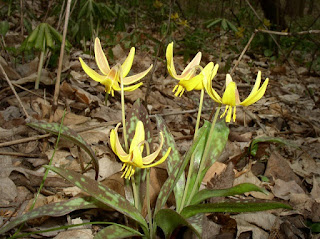 |
Bluebells
and carpenter bee
©
Beatriz Moisset
|
Many
gardeners are developing a new concern for pollinators. They look for
ways to help them. Aware that a perfectly manicured, pesticide-laden
lawn is not good for pollinators they enthusiastically adopt a
scattering of dandelions in the early spring.
This
is certainly beneficial to pollinators. However some of the
passionate claims that accompany this activity are somewhat
exaggerated.
It is not true that pollinators “need” dandelions. They would
prefer other flowers if they had a chance.
 |
Spicebush in bloom
©
Beatriz Moisset
|
 |
Spicebush
and pollinator
©
Beatriz Moisset
|
 |
Spring
beauty and spring beauty Andrena
©
Beatriz Moisset
|
This assortment of flowering plants offers a rich and diverse diet to
newly awakened queen bumble bees, early Andrena bees, and other bees
and flies seeking pollen and nectar. Some pollinators are specialists
on just one or a limited variety of flowers. The spring beauty
Andrena, trout lily Andrena and several willow blossom devotees would
look at dandelions in despair, not being able to make any use of
them.
 |
Trout
lily, frequently visited
by
the trout lily Andrena
©
Beatriz Moisset
|
The biotic community described above not only nourishes early-riser
pollinators but also provides food and habitat for local wildlife.
For instance, the red maple serves as a host plant for more than 100
moth species, willows provide food for several hundred species of
moths. In turn, these caterpillars nourish birds and other wildlife.
By contrast a lawn with dandelions is an impoverished ecosystem with
very limited ecological value, more similar to a refugee camp than to
a healthy, lively community.
 |
Azalea
and its specialist
the
azalea Andrena
©
Beatriz Moisset
|
If the goal is to help pollinators we would reduce the size of the
lawn and grow some of the plants mentioned above rather than simply
allowing dandelions among the blades of grass.
 |
Bloodroot
and Red-necked False Blister Beetle
©
Beatriz Moisset
|
Such
a goal is hard to achieve for most gardeners and probably impossible
or nearly impossible for many of them. So, reducing the use of
pesticides and allowing dandelions, as well as a few other small lawn
“weeds,” is a good decision. But anybody seriously committed
to protecting, not just pollinators, but entire ecosystems would do
well to take a look at other alternatives.
 | ||
Dandelion
and ants
©
Beatriz Moisset
|

I love checking out different species of flowers to see what kind of insects are using them. Lots of interesting treasures turn up in the process.
ReplyDelete